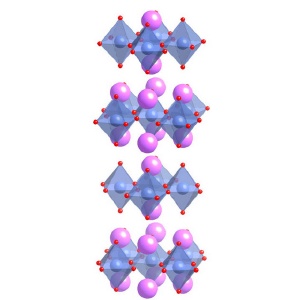May 21 2009
Electrons orbiting the nucleus of an atom act like waves, rather than particles. To study these electrons, particularly the important outer electrons, researchers from the RIKEN Advanced Science Institute, Wako, in collaboration with colleagues from the SPring-8 Center, Harima, have advanced an x-ray spectroscopy technique that exploits this wave-like behavior. They then found unique magnetic and electronic properties in experiments on a recently synthesized oxide of iridium, Sr2IrO4.
 The crystal structure of Sr2IrO4 (pink, Sr; red,O; blue, Ir). From Ref. 1. Reprinted with permission from AAAS.
The crystal structure of Sr2IrO4 (pink, Sr; red,O; blue, Ir). From Ref. 1. Reprinted with permission from AAAS.
Normally, the outer electrons of atoms stop orbiting freely around the nucleus, as they are used in the chemical bonds of a material. In the so-called 5d heavier elements such as iridium, however, the motion of an electron and its spin are strongly coupled properties. This coupling allows the electrons to regain some of the freedom of motion lost to the chemical bonds. As a consequence, an unexpected insulating behavior had been predicted for 5d oxides such as Sr2IrO4.
In conventional neutron diffraction spectroscopy, the study of the often complex crystal structure of 5d oxides has been problematic. However, enhancements by the researchers to the resonant x-ray scattering (RXS) technique have enabled them to probe the complete magnetic structure of a compound using this technique alone. “In the past, RXS has only been used to enhance the x-ray signal, whereas we have now opened up a completely new opportunity,” explains Hidenori Takagi who led the research team.
Using interference effects between the different x-ray beams scattered by the crystal, the researchers can obtain the precise details of the electron waves. 5d transition metal oxides such as Sr2IrO4 are particularly amenable to RXS, as their atomic resonances occur at short wavelengths and therefore produce more complete data. In their study of Sr2IrO4, the researchers determined its full magnetic structure and, more importantly, confirmed the full recovery of the electron’s freedom and hence the predicted unique insulating state.
This insulating state interests physicists because, in combination with certain properties of the crystal structure of some 5d oxides, an even more unusual insulting state—a so-called topological insulator—could develop. Topological insulators are rare but important since they could be used in novel electronic applications that exploit the electron’s spin properties. “Experimentally, identifying a topological insulator amongst these compounds, particularly at room temperature, would be the realization of a big dream,” says Takagi. In the search for topological insulators and other unusual magnetic properties of 5d elements, Takagi and colleagues have established RXS as an ideal method of choice.
*Kim, B. J., Ohsumi, H., Komesu, T., Sakai, S., Morita, T., Takagi, H & Arima, T. Phase-sensitive observation of a spin-orbital Mott state in Sr2IrO4. Science 323, 1329–1332 (2009). | article |